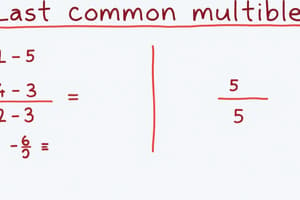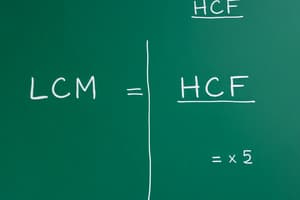Podcast
Questions and Answers
What is the least common multiple (LCM) of the fractions 1/2 and 3/5?
What is the least common multiple (LCM) of the fractions 1/2 and 3/5?
- 15/1
- 3/5
- 3/10
- 15/2 (correct)
Which statement correctly outlines the first step in finding the LCM of two fractions?
Which statement correctly outlines the first step in finding the LCM of two fractions?
- Find the GCD of the numerators.
- Find the LCM of the numerators. (correct)
- Add the denominators.
- Multiply the numerators together.
How do you determine the LCM of the algebraic expressions x^3 and x^2y?
How do you determine the LCM of the algebraic expressions x^3 and x^2y?
- x^5y^2
- x^3y
- x^3y^2 (correct)
- x^2y^3
When finding the LCM of the expressions 3x^2 and 6xy, what is the GCD you will use for the denominators?
When finding the LCM of the expressions 3x^2 and 6xy, what is the GCD you will use for the denominators?
What is the final step to calculate the LCM of the fractions 4/9 and 2/5?
What is the final step to calculate the LCM of the fractions 4/9 and 2/5?
In determining the LCM of the expressions 2xy and 5x^2y^3, what unique factor would you take?
In determining the LCM of the expressions 2xy and 5x^2y^3, what unique factor would you take?
Flashcards are hidden until you start studying
Study Notes
LCM of Fractions
-
Definition: The least common multiple (LCM) of fractions is the smallest fraction that can be formed as a multiple of the given fractions.
-
Formula:
- LCM(a/b, c/d) = LCM(a, c) / GCD(b, d)
-
Steps to Find LCM of Fractions:
- Find the LCM of the numerators.
- Find the GCD of the denominators.
- Divide the LCM of the numerators by the GCD of the denominators.
-
Example:
- For fractions 2/3 and 3/4:
- LCM of 2 and 3 = 6
- GCD of 3 and 4 = 1
- LCM(2/3, 3/4) = 6/1 = 6
- For fractions 2/3 and 3/4:
LCM in Algebraic Expressions
-
Definition: The LCM of algebraic expressions is the smallest expression that can be divided by each of the given expressions without leaving a remainder.
-
Steps to Find LCM:
- Factor each expression into its prime factors (including variable factors).
- Identify all unique factors from the expressions.
- For each unique factor, take the highest power that appears in any of the expressions.
- Multiply these factors together to get the LCM.
-
Example:
- For expressions x^2y and xy^2:
- Factors of x^2y: x^2, y
- Factors of xy^2: x, y^2
- Highest powers: x^2 (from x^2y), y^2 (from xy^2)
- LCM = x^2y^2
- For expressions x^2y and xy^2:
-
General Note: When finding the LCM of algebraic expressions, treat each variable and its exponent similarly to how you would treat numerical factors.
LCM of Fractions
- LCM of fractions is the smallest fraction that can be formed as a multiple of the given fractions.
- The formula for LCM of two fractions ( \frac{a}{b} ) and ( \frac{c}{d} ) is:
LCM(a/b, c/d) = LCM(a, c) / GCD(b, d) - Steps to calculate the LCM of fractions:
- Calculate the LCM of the numerators.
- Determine the GCD of the denominators.
- Divide the LCM of the numerators by the GCD of the denominators.
- Example using 2/3 and 3/4 demonstrates:
- LCM(2,3) is 6.
- GCD(3,4) is 1.
- Thus, LCM(2/3, 3/4) equals 6.
LCM in Algebraic Expressions
- LCM of algebraic expressions is the smallest expression that can be divided by each expression without a remainder.
- Steps to find LCM of algebraic expressions include:
- Factor each expression into prime factors, including variable factors.
- Identify all unique factors present in the expressions.
- For each unique factor, take the highest power appearing in any expression.
- Multiply the factors to derive the LCM.
- Example using ( x^2y ) and ( xy^2 ):
- Factors of ( x^2y ) are ( x^2 ) and ( y ).
- Factors of ( xy^2 ) are ( x ) and ( y^2 ).
- The highest powers identified: ( x^2 ) (from ( x^2y )) and ( y^2 ) (from ( xy^2 )).
- Therefore, LCM = ( x^2y^2 ).
- Important note: Treat variables and their exponents during LCM calculation similarly to numerical factors.
Studying That Suits You
Use AI to generate personalized quizzes and flashcards to suit your learning preferences.




